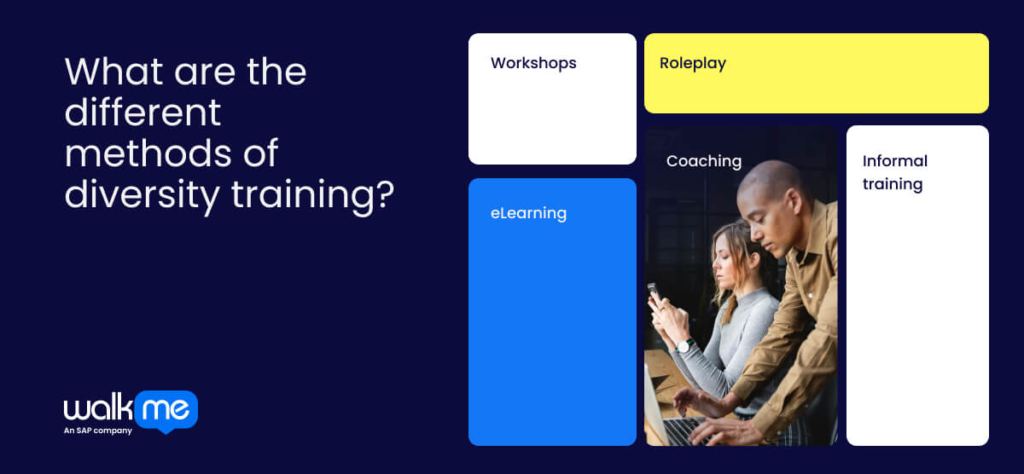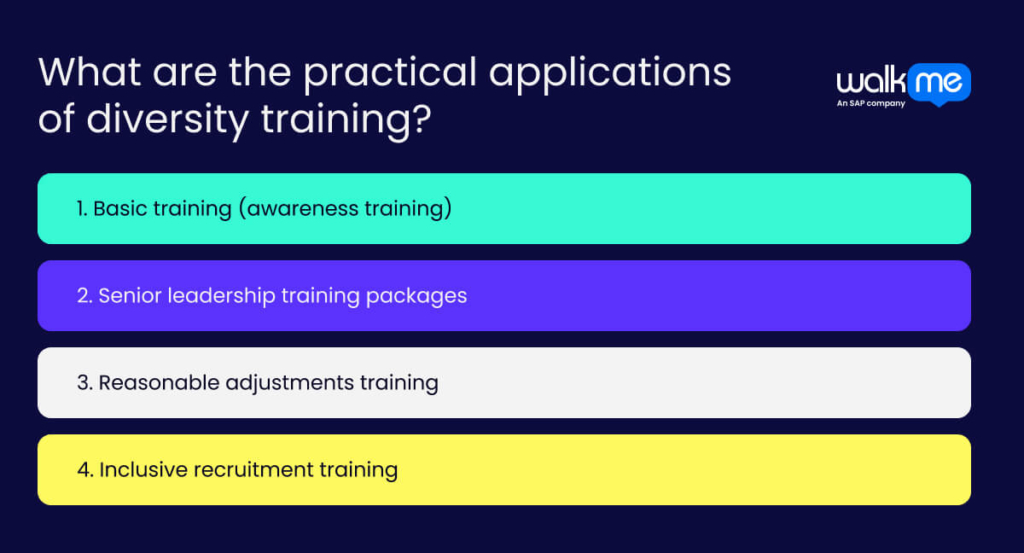Diversity training promotes a culture of workplace diversity, equity, and inclusion (DEI).
It aligns with a talent acquisition strategy, ethical leadership, and progression opportunities to foster an inclusive culture.
Workplace diversity training is a type of employee training that empowers workers and strengthens allyship within the workplace. It encourages stronger teamwork and promotes a deeper understanding of diverse perspectives.
This article will explore the key components of diversity training, including its definition, the best delivery methods, and specific training types that benefit your business. By the end, you’ll understand the what, how, and why of implementing effective diversity training within your organization.
What is diversity training?
Diversity training, or diversity, equity, and inclusion (DEI) training, is a structured educational program designed to encourage an inclusive workplace environment by raising awareness of diversity-related issues and promoting understanding among employees.
It aims to develop a culture that values and respects differences in race, ethnicity, gender, sexual orientation, age, abilities, and other dimensions of diversity.
Diversity training typically covers topics such as:
- Unconscious bias
- Microaggressions
- Inclusive communication
- Anti-racism
- Gender equality
- Intersectionality
- Resistance and solidarity
- Law and policy
Effective diversity training educates participants on the history of discrimination, examines the challenges staff face in your company, and practices behaviors that foster a better organizational culture.
What are the different methods of diversity training?

You can use many of the skills and techniques you’d use for any type of training. This section will explain how the following methods are especially useful:
- Workshops
- Roleplay
- eLearning
- Coaching
- Informal training
However, you may need to rethink your handling of any method. For centuries, educational writers have shown how common pedagogical techniques reproduce the power structures they aim to dismantle. Keep that in mind when planning your program.
Workshops
Many instances of staff diversity training are delivered through workshops. Workshops are an adaptable style of training. They are usually interactive and participatory, with a small group of participants engaging in discussions, activities, and exercises to deepen their understanding.
Workshops create a safe space for employees to share experiences, ask questions, and collaborate. They promote a more inclusive workplace culture by actively involving staff in the learning process and encouraging them to apply diversity principles in their work lives.
Roleplay
Roleplay is a valuable employee training method for delivering diversity training. It allows participants to actively engage with and practice various scenarios related to diversity and inclusion in a controlled setting.
Through roleplay, participants can step into the shoes of different characters, experiencing firsthand the perspectives and challenges associated with diverse identities and backgrounds. It can improve empathy, enhance communication skills, and increase cultural awareness.
eLearning
eLearning methods are highly effective in delivering diversity training as they provide a flexible and accessible platform for participants to engage with content at their own pace and convenience. Through eLearning modules, employees can access diverse perspectives, case studies, and interactive exercises that cater to different learning styles.
eLearning courses can be useful for many types of diversity training. A basic set of anti-discrimination tutorials can contribute to employee onboarding or annual mandatory training. More advanced courses on the legal aspects of discrimination or inclusive conflict management training can be a part of leadership development.
Coaching
A coaching plan can significantly contribute to diversity training by providing personalized guidance and support.
Coaches can work one-on-one with employees to address specific challenges, biases, or concerns related to diversity. They help them develop a deeper understanding of their perspectives and behaviors. The coaching process encourages self-reflection, breeds empathy, and assists individuals in all aspects of organizational diversity.
Informal training methods
Informal training methods, inside and outside the workplace, have a special role in diversity training.
The landscape of diversity and inclusion changes so quickly that formal training methods cannot keep up. However, plenty of resources explain the ups and downs of discrimination and inclusion in society.
Informally consuming resources can give employees the up-to-date information they need. For example:
- Podcasts
- Independent research and reading
- Engaging with social media
- Participation in community events
Acknowledge this informal work. If your staff engages in informal study, they can set the tone for the rest of your company.
What are the practical applications of diversity training?

This section will introduce important examples of practical diversity training. In particular, we will look at:
- Basic training (awareness training)
- Senior leadership training packages
- Reasonable adjustments training
- Inclusive recruitment training
These interventions can all make use of the methods we described above.
To use any of these approaches successfully, you must have a slightly deeper understanding of your organization’s strengths, weaknesses, and opportunities for diversity and inclusion.
As McKinsey research explains, any successful DEI initiative must start with a nuanced understanding of the root causes of your problems. If you don’t understand what’s happening, introducing good training solutions will be impossible.
Basic training (awareness training)
Basic diversity training, often known as ‘awareness training,’ is an introductory program that provides employees with foundational knowledge and awareness of diversity, equity, and inclusion (DEI) principles.
This training aims to sensitize participants to the importance of understanding and respecting diverse perspectives, backgrounds, and experiences within the workplace. Topics may include recognizing unconscious biases, promoting an inclusive environment, and understanding the impact of diversity on organizational effectiveness.
Basic training lays the groundwork for more in-depth diversity initiatives and encourages employees to contribute to a company culture of respect and acceptance. In DEI-positive organizations, basic training will go beyond awareness to skills-based training, in which employees put their work into practice, practicing empathetic listening, conflict resolution, and more.
How to implement basic training
Following these steps, organizations can cultivate a workforce with the skills and understanding to create a more inclusive workplace:
- Integrate your training with onboarding. Introduce basic diversity training at the onboarding stage to instill DEI principles. If it’s a new initiative, consider making it mandatory for all staff members.
- Maximize eLearning. Leverage eLearning platforms for widespread delivery, especially when the initiative is mandatory for the entire workforce. These platforms can be outsourced or developed in-house, providing a flexible and accessible training environment.
- Securing leadership buy-in. Gain significant buy-in from management, particularly within HR, to ensure proper funding and support for the training initiative. Leadership endorsement is crucial for the success and sustainability of diversity training programs.
Tips for using basic training
- Assign inclusive projects: Encourage collaboration across diverse backgrounds to nurture empathy and communication.
- Highlight diverse voices: Ensure tasks include perspectives from different cultures and backgrounds to challenge biases.
- Monitor progress: Review task outcomes regularly and provide feedback to promote inclusivity.
Who’s it for
All employees in your company should complete awareness training to ensure a shared understanding of workplace expectations, policies, and the importance of fostering an inclusive, respectful, and productive work environment for everyone.
Senior leadership training
Senior leadership diversity training is a specialized form designed for executives, top-level managers, and organizational leaders. The focus is on educating senior leaders about the importance of diversity, equity, and inclusion (DEI) at the highest levels of leadership.
Many C-suite executives will need to improve their understanding of the basics of diversity and inclusion, and this training will provide that.
There is a range of other topics that senior leaders need to know about, including:
- Understanding the strategic alignment of diversity and inclusion initiatives with overall business goals.
- Recognizing the impact of diversity efforts on the organization’s reputation and external relationships.
- The legal and governance issues involved include ensuring compliance and minimizing litigation risks.
- Making sense of the KPIs, metrics, and accountability measures for monitoring progress towards diversity goals.
- How to shape and lead inclusive cultures throughout the organization, fostering a sense of belonging from the top to the bottom.
How to implement senior leadership training
To implement an effective training program for leaders, think about the following steps:
- Senior leadership training needs. Few senior staff need advanced diversity training, making in-house programs difficult. External providers can offer specialized training.
- Reverse mentoring. Some executives struggle with basic diversity concepts. Reverse mentoring helps leaders understand LGBTQ issues and social mobility.
- HR’s responsibility. HR must ensure diversity training happens, as C-suite leaders often avoid it. There’s no excuse for skipping it today.
Tips for using senior leadership training
- Tailor training to senior leaders: Focus on advanced DEI concepts that address senior leadership’s unique challenges and responsibilities, ensuring they understand their influence on company culture.
- Encourage self-reflection: Provide opportunities for leaders to assess their biases and leadership styles, fostering personal growth and a commitment to inclusive practices.
- Facilitate ongoing learning: DEI training should be continuous. Offer resources, workshops, and discussions to help senior leaders stay informed on evolving DEI issues and best practices.
Who’s it for?
You should prioritize staff in key positions, such as HR directors. However, everyone involved in line management should have leadership diversity training.
Reasonable adjustments training
Reasonable adjustments are modifications or accommodations made to the work environment, policies, or practices that enable employees with disabilities to perform their job tasks effectively.
Training in this area is an important part of workplace inclusion since it makes a material difference to anyone with a disability. In some cases, adjustments will also be a part of the employer’s legal responsibility.
The goal is to ensure that employees are knowledgeable about and sensitive to the needs of colleagues with disabilities, contributing to a workplace where everyone can fully participate and succeed.
How to implement reasonable adjustment training
If you have a few staff members trained in reasonable adjustments, you will respond to staff needs much more quickly. Use the following steps to make it happen:
- The best option is to engage staff in this kind of training through a third-party provider. They will know and understand the impact you can make.
- Keep your skills updated regularly. Organizations have better models for accommodating diverse needs year after year, so you may need to invest in this training annually.
- Tailor the training to your organization. Reasonable adjustments will differ if you work in manufacturing, logistics, or office-based work.
Tips for using reasonable adjustment training
- Focus on legal obligations: Ensure employees understand the legal requirements for reasonable adjustments, including the rights of individuals with disabilities.
- Promote inclusive practices: Teach practical strategies for implementing adjustments in the workplace, such as flexible hours or adapted equipment, to support diverse needs.
- Encourage ongoing dialogue: Foster an environment where employees feel comfortable discussing their needs and requesting adjustments, ensuring continuous improvement in accessibility.
Who is it for?
Reasonable adjustments training is a great opportunity to reskill members of your HR team. In time, it could be rolled out to any diversity champions across the company.
Inclusive recruitment
Integrating DEI into your workplace means making many small changes in different areas.
However, in others, like recruitment, improving DEI practices requires fundamental changes to hiring processes. Inclusive recruitment training is a specialized program that educates hiring professionals and teams on this.
This training eliminates hiring biases by providing tools and strategies for creating inclusive job postings, conducting fair and unbiased interviews, and implementing equitable hiring practices.
The goal is to build a more diverse and representative workforce by fostering an inclusive hiring environment that values and attracts talent from various backgrounds. It’s a big task, but good recruitment is at the heart of HR’s best practice today.
How to implement inclusive recruitment
Implementing training for inclusiveness will be different depending on several factors:
- If your HR staff is already attentive to DEI issues, informal learning can be a great starting point. Podcasts, books, blogs, and social media can provide examples of the challenges recruits face and the strategies recruiters can use to improve the job-application experience.
- However, if your recruitment team is a bit more “old-style,” you may be compelled to institute some form of mandatory training.
- If you have an embedded culture of inclusion, you may lean back on eLearning methods.
Tips for using inclusive recruitment
- Remove bias from job descriptions: Use neutral language in job postings to ensure they appeal to a diverse range of candidates and avoid unintentional exclusion.
- Broaden candidate sourcing: Expand recruitment channels to reach a wider range of candidates, including underrepresented groups, through job fairs, partnerships, and online platforms.
- Implement structured interviews: Use standardized questions and evaluation criteria to reduce bias and ensure fair assessment of all candidates based on their qualifications and skills.
Who’s it for?
This should be aimed at HR professionals. But it can benefit anyone who participates in hiring.
Nurturing inclusivity through diversity training
Implementing diversity training is a significant step toward fostering an inclusive workplace.
However, it’s important to recognize that such training is just one component of a comprehensive diversity, equity, and inclusion (DEI) strategy, and its effectiveness varies.
Recent studies suggest that traditional diversity training programs have had limited success in increasing diversity within management positions. For example, research indicates that diversity training and grievance procedures can sometimes backfire, reducing workforce diversity.
Nonetheless, implementing diversity training demonstrates your company’s commitment to DEI. Integrating it across all organizational practices—including recruitment, vendor management, and client relations—can drive positive changes that benefit every member of your organization.
FAQs
Diversity training typically includes three key components: education on unconscious bias, which helps individuals recognize and manage biases; promotion of inclusive behaviors to ensure everyone feels respected and valued; and development of cultural competency so employees can communicate effectively and collaborate in a diverse workplace environment.
The most common type of diversity training focuses on raising awareness of unconscious bias. This training helps employees recognize hidden prejudices that affect decision-making, behavior, and interactions. It typically includes workshops, discussions, and activities to create a more inclusive, respectful, and collaborative workplace culture.
A diversity trainer designs and delivers training sessions to improve employees’ understanding of diversity, inclusion, and equity. They educate teams on recognizing and addressing bias, fostering inclusive behavior, and enhancing communication across cultural differences. Trainers create a safe discussion space and help integrate inclusivity into company practices.

